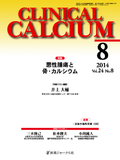Japanese
English
- 有料閲覧
- Abstract 文献概要
- 1ページ目 Look Inside
- 参考文献 Reference
骨転移を形成するがん細胞は,その形成過程において,様々な転移のステップを突破し過酷な生存競争を生き残った結果,骨転移に特徴的な形質を獲得する。 我々は,骨微小環境における腫瘍間質相互作用にはreceptor activator of NF-κB ligand(RANKL)が,骨微小環境におけるがん細胞の増殖には骨基質由来のTGFβが,さらに骨転移巣を形成したがん細胞が治療抵抗性を獲得するメカニズムに遺伝子変異を伴わない転写制御メカニズムであるepigeneticsが関与することを明らかにした。近い将来,骨転移巣形成メカニズムに基づいた分子標的治療法が開発されると確信している。
Cancer cells in the bone metastasis would acquire their characteristic malignant potentials by breaking through the struggle for existence in the various metastasis steps, all of which are required for the cancer cells in the bone microenvironment to emerge as clinical bone metastasis. We have demonstrated that receptor activator of NF-κB ligand(RANKL)was involved in the tumor-stromal interaction in the bone microenvironment and TGFβ stored in the bone matrix was released with the bone destruction, which promoted the proliferation of cancer cells in the bone. We also demonstrated that epigenetics, which is the transcriptional regulatory mechanism without gene mutation, was involved in the acquisition of drug resistance in the cancer cells. We believe that the mechanisms for bone metastasis formation would be fully elucidated in the near future, and the molecular-targeted therapies, which was developed based on these findings, would relief the patients from the fear of death.



